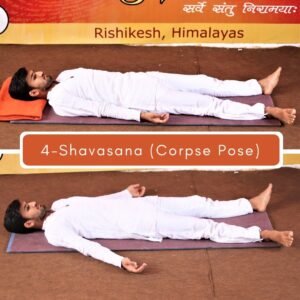While “asana” refers to a stable, safe function for meditation, “exercise” is a more popular movement for the purpose of enhancing energy and endurance. The major variations between exercising and asana may be determined in their methods and physiological consequences.
Asana is a deliberate, sluggish, fluid movement exercise emphasising breath management within a meditative thought-frame, to sell stability and concord within. Exercise usually calls for short, forceful movements that necessitate greater amounts of oxygen to expand muscle, raise the heart rate, and stimulate the sympathetic nervous system.
Exercise and asanas are similar for most people. They are aimed at burning calories. As a result, yoga has gained popularity all over the world as a daily workout. Bookstores carry a variety of yoga-related books with titles like “Yoga for Weight Loss,” “Lose Weight the Yoga Way,” and so forth.
We need to understand the utility and practicality of yoga. And we should always be aware of the fundamental differences between yoga asanas and exercises.
Asana and Exercise Are Not the Same Thing
What distinguishes asanas from physical exercise? Though it depends very much on the type of physical exercise and how it is done, the differences, in a general sense, are as follows:

- Asanas help to balance the emotions and endocrine secretions, resulting in a positive outlook on life.
- When performing asanas, oxygen consumption decreases while physical exercise increases.
- Respiration rate decreases in asanas but increases during exercise.
- In general, quickness is the most important aspect of physical exercise, along with heavy breathing. Consequently, the respiratory system had to exert a great deal more effort.
- While exercise causes a rise in body temperature, yoga reduces it.
- While performing asanas, metabolic rate decreases, whereas it increases with exercise.
- In asanas, the muscles receive little nutrition/oxygen while the organs receive more, whereas in physical activity, the muscles receive the most nutrition/oxygen at the expense of the other organs. Most forms of physical exercise help to develop large muscles. Due to the conversion of muscle tissue to fat, these larger muscles become flabby when not in use. They also require more blood and nutrients.
- While exercise raises blood pressure and heart rate, making the heart work harder, asanas lower these parameters.
- In general, yoga practitioners require less food than people who practice physical exercise to maintain and manage their weight properly, whereas stopping physical exercise causes you to gain weight because physical exercise increases their hunger.
- Asanas stimulate the parasympathetic nervous system, whereas exercises stimulate the sympathetic nervous system—there is a significant distinction between yoga asanas and exercise.
- Physical workouts overwork the joints, which can result in rheumatism and stiffness later in life. The contrary is genuine for asanas.
- Exercise tends to overstress the joints, which can lead to stiffness and rheumatism in later life. When it comes to asanas, the opposite is true.
- In asanas, the muscles get less oxygen and nutrition while the organs get more, but during physical activity, the muscles get more oxygen and nutrition as compared to other organs.
- While exercise can lead to a buildup of toxins, asanas help the body detoxify.
- There is a significant difference in what each method of practice is teaching the body to prioritize.
- Exercise applies energy, and you will feel tired; asana preserves energy, and you feel refreshed.
- Exercise is intense, fast, and repetitive; asana is slow and often non-repetitive movement.
- While exercises activate the sympathetic nervous system, asanas activate the parasympathetic nervous system.
- Exercise raises the metabolism of the body; asana reduces it.
- Asanas decrease oxygen consumption, whereas exercise significantly increases it.
- Asana encourages natural, deep breathing even as it reduces respiration, whereas exercising promotes heavy breathing and an extended respiratory rate.
- While exercise increases body temperature, asana lowers it.
- Asanas stretch and extend muscular tissues, increasing flexibility, whereas exercise often shortens muscular tissues and causes them to become stiff.
- Asana provides internal organs more oxygen and nutrients, while exercise provides muscle tissue more oxygen and nutrients.
- Asana engages this parasympathetic anxious system, allowing the activity of relaxation, while exercise engages the sympathetic frightened machine that facilitates the fight-or-flight mechanism.
- Asana conserves and enhances energy, while exercise consumes and empties energy.
- Asana lowers muscle tension, whereas a workout increases it.
- Asanas are suitable for people of every age and fitness condition, which includes people who are sick, while strenuous physical games are reserved for younger, healthier individuals.
- Regular asana exercise requires less food, while exercising will increase the desire for food.
- Asana gives endless opportunities for self-cognizance improvement; workouts, on the other hand, normally lack this factor.
How do I Determine the Best Asana or Exercise?
A well-rounded habit regularly consists of both exercise and yoga asanas, which provide stability and mobility.
Make Sure Your Approach is Fair

Combine Physical Activities with Asanas:
An ideal health often combines the ability and precision of asanas with the dynamic and frequently more extreme nature of traditional exercises.
Fill in the Gaps
Try asanas to expand your range of motion if your regular exercises don’t give you enough flexibility.
Guarantee Uniformity and Familiarity
Recognise any limitations or pain and adjust your exercise accordingly.
Conclusion
Asana and exercise are two different approaches, and both of them aim to improve health. By understanding the distinctions, we can develop a strategy that supports the mind and spirit. You can practice any one of these as per your preference.
Explore More:-




